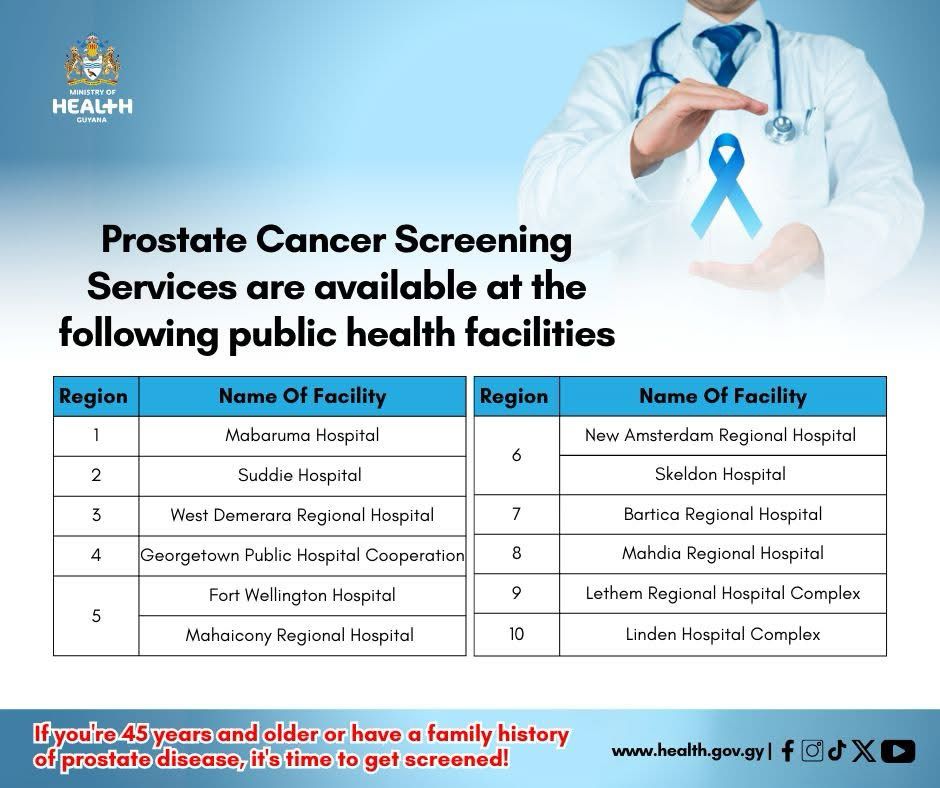Prostate cancer is one of the most common cancers among men in Guyana and the Caribbean. Despite advances in diagnosis and treatment, the disease remains the leading cause of cancer-related deaths in Caribbean men. Awareness, early detection, and access to modern treatment options are crucial to reducing its burden in the country.
Understanding Prostate Cancer
The prostate is a small, walnut-sized organ located just below the urinary bladder. It produces seminal fluid and plays a key role in male reproductive health. As men age, the prostate can develop various conditions, with the two most common being benign prostatic hyperplasia (BPH) and prostate cancer. BPH, also known as an enlarged prostate, is a condition distinct from prostate cancer and does not lead to cancer. The risk of prostate cancer increases with age, genetic predisposition, and lifestyle factors.
Prostate Cancer in Guyana: Statistics and Challenges
According to recent data from the Ministry of Health, prostate cancer is the leading cancer among men in Guyana, with 126 new cases diagnosed in 2024. Many cases are at an advanced stage or metastatic at the time of diagnosis, when treatment options become more limited and less effective. This is often due to lack of awareness, cultural stigma surrounding digital rectal exams (DRE) and prostate-specific antigen (PSA) testing, as well as the absence of structured screening programs.
It is well established that Caribbean men of African descent have a higher risk of developing aggressive forms of prostate cancer. Men of African ancestry account for more than two-thirds of all prostate cancer cases in Guyana. This highlights the need for aggressive and targeted screening efforts among high-risk groups.
However, no ethnic group is exempt, and prostate cancer affects men of all backgrounds.
The Importance of Early Detection and Screening
Screening and early detection of prostate cancer have demonstrated a reduction in mortality risk by up to 46%, according to a major European study. Early screening facilitates the diagnosis of cancer at initial stages when curative treatments are most effective, resulting in fewer complications and lower costs.
The PSA test is the primary screening tool. It is a simple blood test that measures the level of prostate-specific antigen in the blood. Elevated PSA levels may indicate prostate cancer but can also be associated with benign conditions like BPH or prostatitis. The Digital Rectal Examination, while still an optional screening method, has become less popular due to the stigma and fear it induces among men.
In Guyana, PSA testing is available in both public and private healthcare facilities. Despite its accessibility, many men do not take advantage of this service due to fear, embarrassment, or misinformation. The challenge lies in normalizing prostate cancer screening as a routine health check, similar to how mammograms and Pap smears are encouraged for women.
Prostate Cancer Diagnosis and Treatment
1. Prostate Biopsy
If a man has elevated PSA levels or abnormalities detected during a DRE, a prostate biopsy is required to confirm the diagnosis.
Advancements in local pathology services have reduced the waiting time for results to about a week.
2. MRI-Targeted Biopsy
Traditional biopsies can sometimes miss aggressive cancers. Multiparametric MRI (mpMRI) now allows for more targeted biopsies, improving the accuracy of diagnosing high-risk tumors. This is especially beneficial for patients with persistently high PSA levels but negative biopsy results.
3. Treatment – Localized Disease
If prostate cancer is diagnosed at an early stage, imaging tests such as CT or MRI help determine whether the cancer is confined to the prostate. If no spread is detected, curative treatments such as radiotherapy or radical prostatectomy are recommended. Both of these treatment options are readily available in Guyana.
4. Treatment – Advanced or Metastatic Cancer
For men diagnosed with meta static prostate cancer, curative treatment is no longer an option. However, hormonal therapy, chemotherapy, and other palliative treatments can help manage symp toms and improve quality of life.
Breaking the Stigma: Encouraging Men to Get Tested
One of the biggest barriers to early detection in Guyana is the cultural stigma around prostate exams. Many men avoid screening due to misconceptions about DRE or fear of a cancer diagnosis. This has to change.
Public education campaigns led by healthcare professionals, community leaders, and even prostate cancer survivors can help dispel myths and encourage more men to get screened.
Moving Forward: A National Approach to Prostate Cancer
Recognizing the urgency of addressing prostate cancer, the Ministry of Health launched a comprehensive national strategy. In November 2024, the National Guidelines for the Management of Prostate Health were published. These initiatives are already showing positive results:
Widespread Screening Programs
Government-run facilities, private healthcare providers, and non- governmental organizations have collaborated to increase the accessibility and affordability of PSA testing. In 2024 alone, more than 13,000 PSA tests were conducted, and approximately 500 prostate biopsies were performed in Guyana.

Public Awareness Campaigns
Media campaigns, health fairs, and community outreach programs have played a role in educating men about the importance of early detection.
Training for Local Medical Practitioners
The Men’s Health Unit of the Ministry of Health has been conducting training sessions for healthcare professionals across all ten regions of Guyana to improve diagnostic and treatment capabilities.
Access to Advanced Treatment
Partnerships with international medical institutions will help to introduce newer treatment options to Guyana. Additionally, the 2025 National Budget has allocated funds for a National Cancer Treatment Centre, which is expected to enhance the quality of prostate cancer care in the country.
Conclusion
Prostate cancer is a silent threat that claims too many lives in Guyana. But with increased awareness, early detection, and access to modern treatment options, we can change the narrative. It is time for men to take charge of their health, for the medical community to push for better resources, and for the government to make prostate cancer a priority in national healthcare policy. By working together, we can ensure that prostate cancer is detected early, treated effectively, and ultimately save lives.













